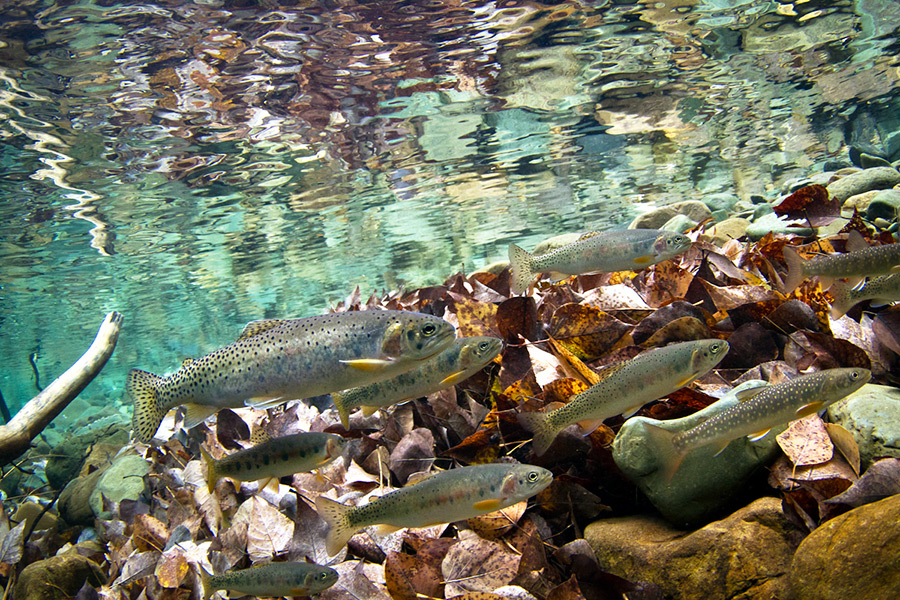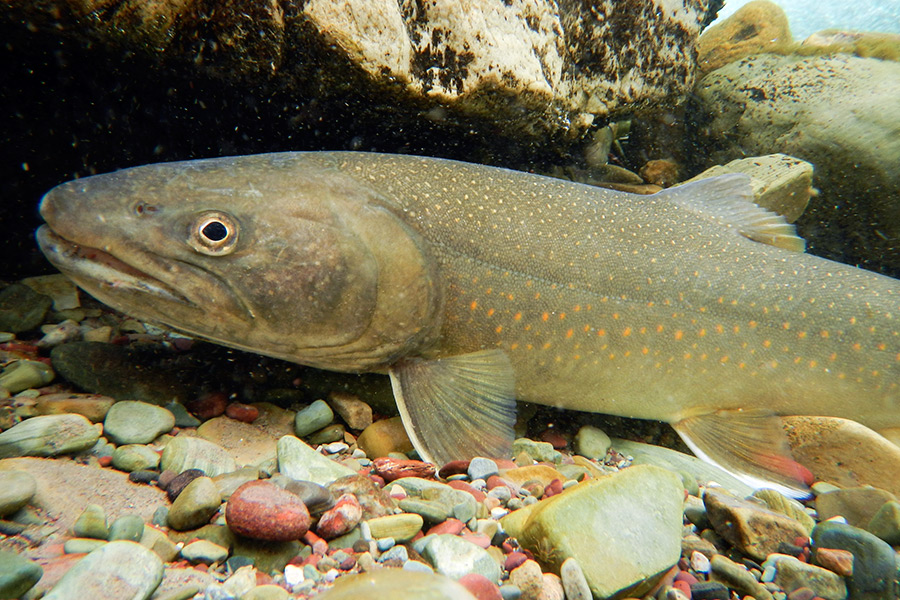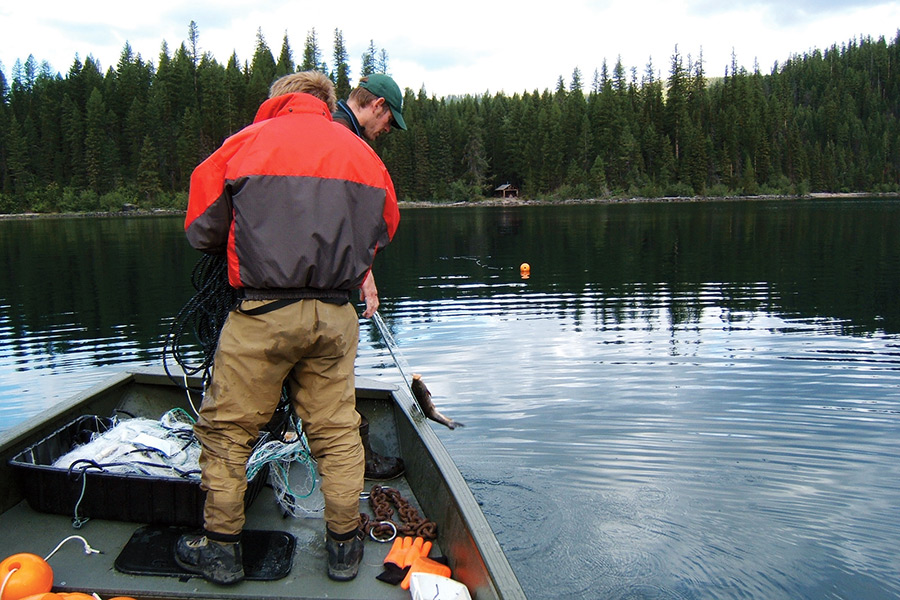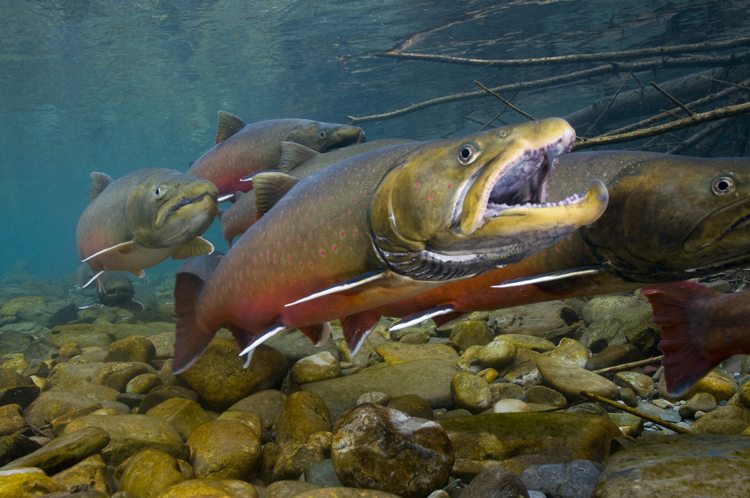Fisheries managers with Montana Fish, Wildlife and Parks (FWP) say they are concerned about declines in the number of bull trout spawning nests, or redds, in western Montana, prompting the formation of an interagency working group, according to an April 27 press release. Bull trout are native to Montana and are listed as a threatened species under the Endangered Species Act.
Although northwest Montana and Glacier National Park have historically remained one of the last best strongholds for native bull trout in the state, the region has seen its wild populations decimated by the explosion of invasive lake trout. Fisheries managers also blame reduced stream flows and warming water temperatures as among the most critical stressors imperiling the species’ long-term survival, which depends on cold, clear and connected aquatic habitats.
According to FWP’s monitoring data, which spans more than 40 years, declining redd numbers were documented at 48% of FWP’s monitoring sites last fall. They were shown to be increasing in 12% of the sites and registered as stable in 40%.
Generally, monitoring sites within “quality and connected habitats,” such as the South Fork Flathead River and Hungry Horse Reservoir, have seen relatively stable or slightly increasing population sizes, according to FWP. Many smaller populations in habitats that are lower quality or not connected with other populations are mostly stable or declining, the agency stated.
“Bull trout need clear, cold water and complex, connected habitat,” Eric Roberts, FWP’s fisheries management bureau chief, said. “We’ve done a lot of work to provide for these things in bull trout streams and we need to look at doing more.”

FWP has engaged in recovery projects such as large-scale habitat improvements, removal of fish passage barriers and adjustments to fishing regulations. FWP will continue to work with resource agencies, landowners, and water users to address passage barriers and improve stream flows and habitat.
“Over the years we’ve had many projects to improve bull trout numbers and it continues to be a focus for us and our partners,” Roberts said.
The South Fork Flathead River remains a stronghold for bull trout in part because the Hungry Horse Dam guards against invasive lake trout infestations from Flathead Lake. The South Fork also tracks through the Bob Marshall Wilderness Area, where environmental protections are in place.
To further respond to the decline of bull trout, FWP and the U.S. Fish and Wildlife Service (FWS) will form an interagency working group this winter to address bull trout issues and to coordinate recovery efforts. The group will include members from federal and state agencies, tribes, researchers and non-governmental organizations. Input from the group will help inform a statewide conservation strategy being developed by FWP and partners.
“Bull trout recovery is going to require all of us to work together, we appreciate the leadership of FWP and all those involved to help recover this species,” said Dan Brewer of the FWS in Montana.
In Glacier National Park, fisheries biologists have partnered with the U.S. Geological Survey to pioneer new techniques to suppress lake trout in remote backcountry lakes and reintroduce dwindling bull trout populations, with recent results showing strong evidence of success. Results also indicate that the efforts could be applied to other invaded habitats and across broader ranges.
According to Clint Muhlfeld, an aquatic biologist with the U.S. Geological Survey (USGS), the research arm that helps inform federal management and recovery of the species, the suppression project has shown strong evidence of success in reducing lake trout and is hailed as one of the first successful projects of its kind.
However, new research reveals that invasive lake trout and other aquatic invaders disrupt entire food webs upon which native species like bull trout are reliant. For example, a 2021 study published in the prestigious journal Proceedings of the National Academy of Sciences used long-term fisheries monitoring records to determine the timing of lake trout invasions in 10 northwestern Montana lakes, and analyzed food webs from those lakes to determine how they changed and impacted native communities as their invasions progressed.
The research team showed that lake trout disrupted food webs by forcing native fish species to feed on suboptimal food sources in different habitats, eventually causing the loss of the native predator, bull trout, a threatened species protected under the U.S. Endangered Species Act.
“Native bull trout populations have drastically declined in many lakes across western Montana due to competitive interactions with invasive lake trout,” said Muhlfeld. “For the first time, we showed what happens not only to bull trout but entire food webs supporting them as lake trout invade and upset lake ecosystems over time.”

Lake trout populations exploded after the state introduced mysis shrimp into the upper Flathead Drainage in 1968, and appeared in Flathead Lake in 1981. The increase in non-native lake trout led to the collapse of the kokanee salmon fishery and steep declines in native fish, including bull and cutthroat trout. It’s an oft-cited example by local fisheries managers and conservationists to illustrate how invasive species erode biodiversity and lead to steep economic losses, including about $120 billion in annual damages in the U.S. alone.
For the past four decades, state biologists annually travel more than 200 miles of streams and collect information from spawning areas, counting the number of spawning nests, called redds. Redd counts are indicative of the abundance levels of spawning adult bull trout each year and are used to assess status and trends in bull trout populations in northwest Montana.
While FWP biologists say the decline of bull trout redds is mostly due to warming water and altered stream flows, loss of habitat, and predation by and competition with non-native fish, such as northern pike and lake trout, hybridization with brook trout can also impact bull trout. Other contributing factors are reduced fish passage and habitat degradation.

Maintaining the health of local bull trout populations throughout the Flathead River Basin is critical to the species’ overall health, Muhlfeld said.
“It’s like lightbulbs going out on a Christmas tree,” he said. “At first it’s just one or two bulbs that burn out, but before long, they all might wink out and that is why managers are concerned about conserving all these local populations. Because even if they’re small they represent these unique behaviors and life histories with specially adapted genetic propensities. So as we lose individual bull trout populations, we lose that genetic diversity.”
Trout anglers will see little impact on opportunity as steps are taken to address bull trout issues. Catch-and-release angling of bull trout is allowed in Lake Koocanusa and the South Fork Flathead River (above Hungry Horse Reservoir), and harvest of bull trout is still allowed in Hungry Horse Reservoir. These waterbodies remain strongholds of bull trout in Montana. However, FWP will explore opportunities to suppress non-native fish, such as lake trout and northern pike, to benefit bull trout, which could limit opportunity in some non-native sport fisheries where they overlap with important bull trout populations.
